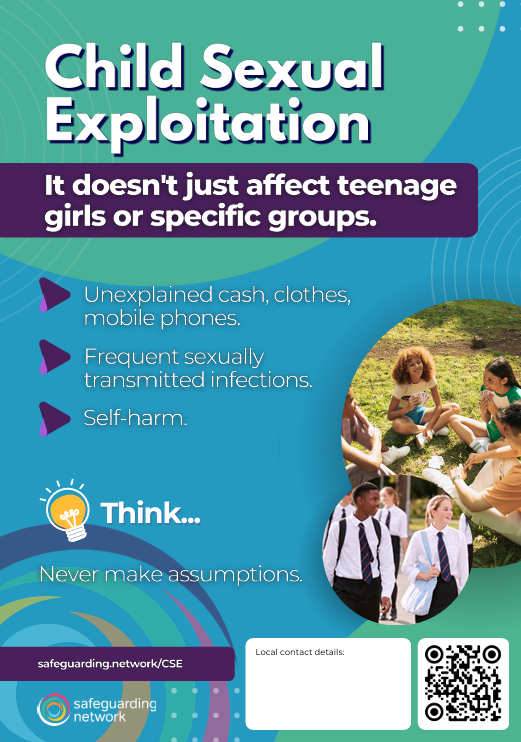Introduction
Child sexual exploitation (CSE) is not just something that affects teenage girls or specific groups and can happen in and out of school. Any child or young person can be tricked into believing they are part of a loving and consensual relationship that could be framed as friendship, mentoring or romantic and may not realise they are being exploited.
CSE can happen in education settings, in the community and online. The abuse can occur over time or be a one-off occurrence and may happen without the child’s immediate knowledge, for example through others sharing videos or images of them on social media.
Need more?
Thank you for visiting our resources pages. These are free to everyone as is our fortnightly safeguarding bulletin – general safeguarding information is too important to restrict. Become a member to access lots more, including training materials for you to deliver in-house on each topic in Keeping Children Safe in Education.
Sign up for FREE fortnightly bulletin.
What about training?
We can deliver training for your setting on this and other subjects via online platforms, or face-to-face in certain areas. Just get in touch to discuss your requirements.
Anyone working with children and young people should be aware of how child sexual exploitation can occur, what to look for and what to do.
If you're worried a child or young person is being sexually exploited contact your local children’s services, or phone the police.
Definition of child sexual exploitation
CSE is a form of sexual abuse that occurs “where an individual or group takes advantage of an imbalance in power to coerce, manipulate or deceive a child into taking part” in sexual activity, in exchange for something the victim needs or wants, and/or for the financial advantage or increased status of the perpetrator or facilitator and/or through violence or the threat of violence.
Adapted from Keeping Children Safe in Education
Prevalence
- According to the NSPCC, 86,962 sexual offences against children were recorded by police across the UK in 22/23, including rape, sexual assault, grooming and sexual exploitation.
- In the first six months of 2024, the IWF reported that child sexual abuse reports related to sexual extortion increased by 19%.
- The NSPCC also says that online grooming crimes against children have increased by 89% in six years.
Additional vulnerabilities
Any child can be vulnerable to sexual exploitation. Children and young people are more vulnerable to abuse when they:
- have previous experience of neglect, physical and/or sexual abuse
- lack a safe/stable home environment, now or in the past (due to domestic abuse or parental substance misuse, parental mental health issues or criminality, for example)
- experience a bereavement or loss
- are socially isolated or have social difficulties
- don’t have a safe environment to explore their sexuality
- are economically vulnerable
- are homeless or in insecure accommodation
- have connections with other children and young people who are being exploited in any way
- have family members or other connections involved in adult sex work
- have a physical or learning disability
- are in care (particularly those in residential care and those with interrupted care histories).
Child sexual exploitation is never the victim’s fault. Avoid suggesting young people might be making ‘lifestyle choices’ to be abused, or minimising concern because they have ‘agreed to’ or received something for the abuse. These are indicators of heightened vulnerability.
A child or young person might believe that their abusers were their ‘friends’ or ‘boy/girlfriends’. For some young people the relationship fulfils an emotional need to be loved or a physical need, such as shelter.
Just because there’s not a significant age gap or an immediately apparent imbalance of power, doesn’t mean a child or young person is not being exploited. It’s important to consider ‘capacity to consent’.
‘Capacity’ should not only include age but also developmental stages and the child or young person’s ability to understand consent. Always consider the impact of the grooming and coercion because many children do not believe they are being exploited but instead are part of a caring relationship.
Sometimes action has not been taken because there is ‘insufficient evidence to prove abuse’. The burden of proof to begin a child protection enquiry is far lower than to secure a conviction. If you have reasonable cause to suspect abuse, the local authority must investigate.
Spot the signs
Sometimes there are indicators, sometimes there are none, and professionals can dismiss these as simply the behaviour associated with children and young people growing up.
Signs can include a child or young person who:
- acquires money, clothes, mobile phones, etc., without plausible explanation
- has gang association and/or isolation from peers/social networks
- is excluded or has unexplained absences from school, college or work
- leaves home/care without explanation and persistently goes missing or returns late
- receives excessive numbers of texts/phone calls
- returns home under the influence of drugs/alcohol
- undertakes inappropriate sexualised behaviour for their age/develops sexually transmitted infections and/or pregnancy occurs
- displays evidence of/suspicion of physical or sexual assault
- has relationships with controlling or significantly older individuals or groups
- has multiple callers (unknown adults or peers)
- frequents areas known for adult sex work
- has concerning use of the internet or other social media
- displays increasing secretiveness around behaviours
- self-harms or displays significant changes in emotional wellbeing.
What to do
- Check young people have safe relationships – in their family, with their peers and with your staff. Create a culture where it’s okay to talk, even about the most difficult things.
- Always take young people seriously.
- Be aware of additional vulnerabilities – are there children at your setting who may be particularly vulnerable to sexual exploitation? Could they benefit from early intervention?
- Consider the child’s lived experiences. Build and use your relationships with children and young people to understand what’s happening in their community (in school, locally and online). Be aware of the strong influence of peers and social media.
- Listen to/observe the ‘voice’ of the child. Children and young people often find it difficult to speak about their experiences – what is their behaviour trying to tell you? Work with them to build trust and be a safe person for them to come to when needed.
- Avoid victim-blaming language that can deflect attention from and down-play the experiences of victims leading to lack of confidence in reporting and broken trust.
- Don’t make assumptions about the level of independence or control a child or young person has simply by the way they present themselves to you and others.
- Share information at an early stage about concerns. You may be preventing CSE by working with children and young people who experience neglect, domestic abuse or a breakdown in their relationship with their parents.
- Work closely with parents and families, in agreement with your safeguarding lead, and where it’s appropriate, work closely with families to understand and reduce the risk.
- Ensure that interventions are as child-centred and trauma-informed as possible. Protective work should be long-term and not simply focused on changing the child or young person’s behaviour.
- If a child or young person finds it difficult to engage with services or attend meetings, such as police interviews, consider why and what support could be put in place. Children may need reassurance that they are being taken seriously.
- See this as your responsibility – raise it with your designated safeguarding lead, follow your school’s safeguarding policies and listen carefully to the advice you are given. Take it higher if you feel concerns are not being taken seriously. Make a referral yourself if you need to and follow your local escalation procedure to raise concerns between agencies. If a child is at immediate risk, call the police.
Take action – and keep taking action until you know that children and young people are safe.
FREE child sexual exploitation poster
This downloadable resource raises the profile of safeguarding for your staff team. For use in staff rooms, on safeguarding boards or on the back of toilet doors, the poster includes tips, a space for local contact details, plus a link and QR codes to this resource page. Find the poster in the resources below.
DSL Training Materials
-

Child Exploitation Presentation
-

Child Exploitation - Presenter Notes
-

Handout for staff - Child Sexual Exploitation
-

Child Sexual Exploitation Quiz
-

Child Sexual Exploitation Quiz (Answers)
-

Child sexual exploitation scenario - EYFS
-

Child Sexual Exploitation Scenario – EYFS settings – DSL Information Sheet
-

Child sexual exploitation scenario – Primary Schools
-

Child Sexual Exploitation Scenario (Primary) – DSL Information Sheet
-

Child Sexual Exploitation scenario – Secondary Schools
-

Child Sexual Exploitation Scenario (Secondary) – DSL Information Sheet
-

Child sexual exploitation scenario – 16+ settings
-

Child Sexual Exploitation Scenario (16+) – DSL Information Sheet
-

Child sexual exploitation scenario – SEND settings
-

Child Sexual Exploitation Scenario (SEND) – DSL Information Sheet
-

Child sexual exploitation scenario – Care Settings
-

Child Sexual Exploitation Scenario (Care) – DSL Information Sheet
Resources
-

Child Sexual Exploitation Poster
-

Data Insights Hub [2024]
-

SAVE ME film and facilitator handbook
-

Child sexual exploitation: learning from case reviews
-

Using Appropriate Language
-

Childline – Healthy and unhealthy relationships
-

Advice regarding the sharing of nude and semi-nude images
-

Child Sexual Exploitation: Definition and Guide for Practitioners
-

Childline – Report Remove tool
-

Alternative Terminology
-

It’s Not on the Radar
-

Consent: It’s as Simple as Tea
Save time and improve your safeguarding approach…
Bite-size training materials to share with your staff every month.
Support to explore and develop your safeguarding culture.
A huge array of resources and professional experience at your fingertips.
Get in touch now for a personal tour of the site and details of membership benefits.
We look forward to working with you.


